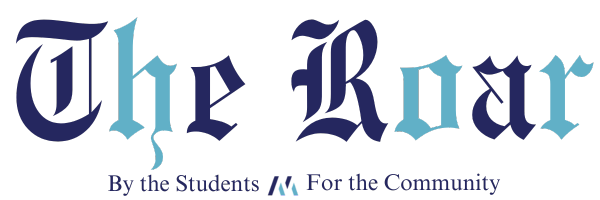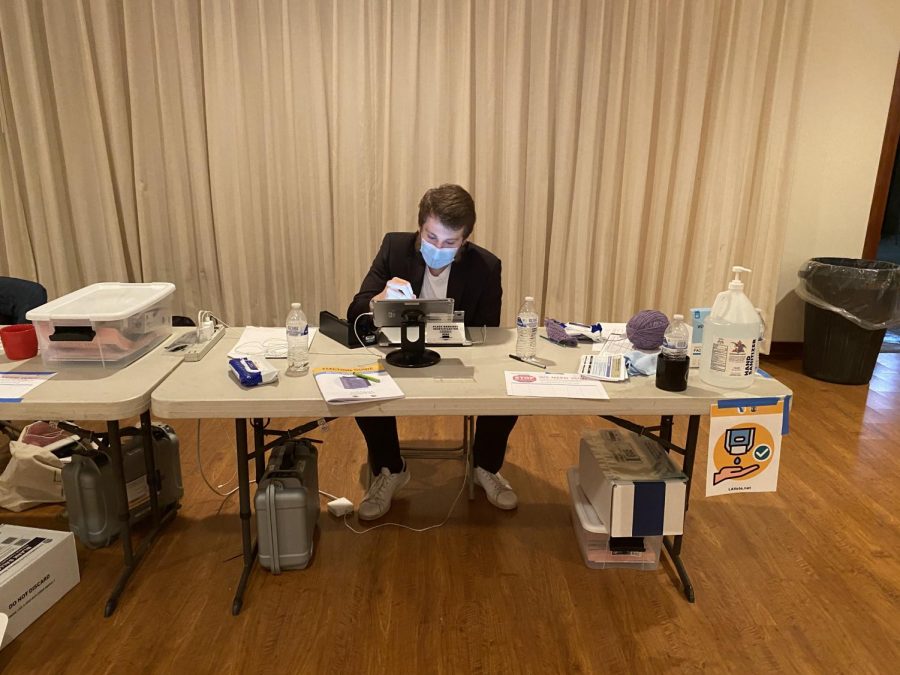A Monumental Election: The Milken Community Gets Involved
Photo Provided by Jake Tweed- Field
Poll worker Jake Tweed-Field ’21 at the WDOC Sooky Goldman Nature
Troy Yroshalmiane ‘23 sat in bed hitting refresh on the ever-changing Google election map.
He was watching the news and coverage on Google while flipping between multiple channels as he talked on the phone with a few friends. For hours, Troy and his Milken classmates argued about which states their favorite candidates would need to win, screaming with frustration or triumph each time the map changed. Across Los Angeles that night, Milken students like Troy gathered with family and friends, glued to their screens and united in forgetting about their homework or upcoming assessments.
The uncertainty and stress that Milken students faced as a result of the recent presidential election was a mirror image of the feelings felt across America. Further, the political divisions in America are seen on a smaller scale within the Milken community. However, while much of America remains strongly divided along partisan lines, many Milken students came together to involve themselves in this election and take steps to aid in clearing some of the doubt and anxiety. Students have volunteered at the polls, observed news from varying sources, and cast their own ballots, all in an effort to make their voices heard.
This election is both monumental and vastly different from every other election the United States has had before. The turnout was projected to have been 68.6%–72.1%, much higher than the 60.1% that was reported in 2016 and higher than nearly all elections from previous years. People have understood the gravity of this election, and, therefore, have showed up to the polls in record numbers to stand up for what they believe in.
Kayla Dadbin ‘21 voted for the first time this year at the Roxbury Park Community Center. “I wanted to vote because I believe that even one person can make the slightest change in our democracy. I also wanted to vote because I felt that I was lucky enough to turn 18 before such a crucial election.”
To better understand the Milken community’s perspective and behavior with regards to the election, The Roar distributed an anonymous survey before November 3rd to Milken’s faculty and students, which received 238 responses.
The results reveal a stark divide in political ideology with 40.8% identifying with the Democratic Party and 39.8% with the Republican Party (a difference of only three votes) with Independents and Third Parties making up the rest of the data. Joe Biden was Milken’s preferred candidate at 50.8% with President Trump trailing at 42.4% and third party candidates and abstentions making up the last 6.7%.
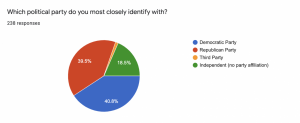
Notably, 72% of the respondents were not eligible to vote. This is why Mrs. Ordower, Director of Service Learning, took it upon herself to continue the “phenomenal” legacy of the late Tony Lawrence, the history and government teacher who used to run this program, to ensure that non-eligible voters find ways to participate in the election and to encourage eligible voters to “take part of their democracy.”
One of the ways Ordower went about this was with the help of special guests like Fran Lapides, a former Milken teacher and member of the League of Women voters, who educated the seniors on the importance of voting and how to do it. In addition, she was able to recruit more than a few 11th and 12th graders to deliver postcards reminding residents to vote all over Los Angeles county. Ms. Ordower explained it as a melting pot that “connected us as a community.”
Finally, after doing tons of research on the safest and most impactful ways to help out in the election, Ms. Ordower reached out to many government, history, and civics class teachers urging them to encourage their students to volunteer at the polls. After 8 hours of training, 11 hours on a Saturday and Sunday, and 14 hours on the day of the election, 11 people rose to the occasion.
Taylor Golshan ‘21 is one of those students: a senior who spent three days and almost 40 hours working the polls located at the Skirball Center. “I am still 17 so I cannot vote yet,” she says. “I still wanted to do something for my country and community. It felt really good to be a part of something bigger than myself.”
Golshan speaks Farsi, which helped her connect with Persian-American voters and guide them more swiftly through the process: “It was really nice to be able to communicate easier with the Farsi speakers that came to cast their vote. I liked making the process an easier and more fun experience for them.”
Golshan’s work day started by getting voters their ballots and explaining the entire process to them. She then spent her time standing by the machines and helped individuals who did not understand the voting process and ensured that they did all of the right steps to make their vote count. She also helped facilitate the line so that everyone was following pandemic guidelines and there were not too many people inside at once. At the end of the process, she helped clean up and put all of the materials away. Golshan was in charge of counting the ballots which she enjoyed doing as it was exciting to guess which candidate would win. Taylor takes the experiences and lessons she learned, such as people skills and more about the voting process in general, and uses it in her everyday life.
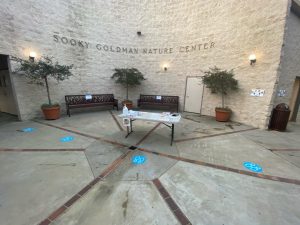
Briyana Bekhrad ‘22 learned about poll work from her AP Government teacher, Mr. Painter. Wanting to see history take place in front of her eyes, Bekhrad jumped at this opportunity: “Right as I walked in, I noticed the organization and cleanliness of the voting room with hand sanitizer everywhere, and people at all stations offering guidance” said Bekhrad.
The COVID-19 pandemic has not only caused economic turmoil and social disruption but has also massively affected the process of voting in the 2020 election. One student at Milken, Elinor Barnea 21’, worked at the polls and had to strictly adhere to specific guidelines due to the pandemic: “We had to wear two face masks, a face shield, gloves, and were directed to apply hand sanitizer frequently. We also had to wipe down the screens after each person had used it and to hand out gloves to everyone. Anyone who was not wearing a mask was not allowed to cast their vote in person.” The guidelines for in-person voting were following all pandemic guidelines however some voters were not willing to adhere to them.
Taylor Golshan also had an experience where someone refused to wear a mask. Golshan explains, “I noticed this man not wearing a mask at the booth so I let the lead know. The man continued to argue with the lead and explain to him that voting was his right and how he didn’t need to wear a mask for it. The volunteers explained how it was a health hazard and he could easily vote curbside yet he persisted and refused to leave. His kid started crying, which caused him to leave yelling ‘communists!’ to everybody.”
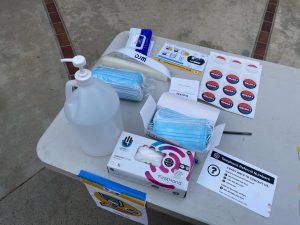
The pandemic has clearly affected the way in which American citizens vote but also the way we perceive the election and the candidates. Shahrzad Townsend ’21 discussed how each presidential candidate used the pandemic to their advantage and how, consequently, the COVID-19 pandemic became a political issue. She noted, “Trump used the pandemic to attract his no-mask, non-COVID believers and wanted to open up the country while Biden caught voters’ attention by taking the pandemic more seriously.” Thus, both presidential candidates had used the pandemic to uplift their public image in two directly opposite manners.
Another aspect that distinguishes this election from others is mail-in voting, a practice that has been used at an exponentially higher rate this election due to the COVID-19 situation, which renders in-person voting potentially dangerous for many. Controversy over mail-in ballots sparked due to online videos, (many of them have been debunked), which appeared to show people burning and stealing ballots. In addition, there were also instances where people set up fake ballot drop-off boxes to potentially affect the outcome of the election.
For months leading up to the election, President Trump questioned the validity of these ballots. In 2016, 24.9 million people voted through a mail-in or absentee ballot. This number shot up in this past election, with nearly 64 million voters having cast their mail-in ballot before election day. Democrats were more likely to vote by mail as well, partially due to Trump’s disparaging comments regarding their validity, which led to the “red mirage” many saw on election day, as primarily democratic-voting mail-in ballots were not counted until later.
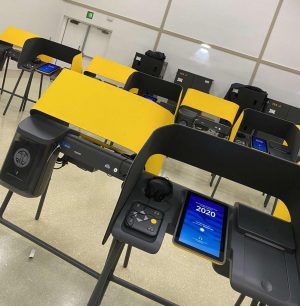
This was seen heading into election night as while Biden held a substantial lead over Trump in the polls, Trump seemed to have a clear path to victory with an early lead in states like Michigan, Wisconsin, and Pennsylvania as they were only able to start counting mail-in ballots after polls closed. Trump performed much better among in-person ballots, which were counted first, resulting in leads of over 100,00 votes in many states.
This also led to much uncertainty and confusion, as it took days until key battleground states were predicted and the election results were finally announced. As mail-in ballots tricked in, Biden eventually passed Trump in all 3 states. Trump claimed the counting process was rigged and has filed lawsuits, which seek to prevent votes from being counted in some states, However, in states like Arizona and Nevada where he needs votes, he wants them to be counted. Although Biden has been named the President-elect, Trump is seeking to contest the results in the courts.
While the future of the Supreme Court was a contentious issue in this past election, Milken chose to discuss it from a productive and unifying perspective. When Ruth Bader Ginsberg died in September, Milken’s counselors knew they wanted to commemorate her death. For 50 years, she worked in law, becoming a liberal feminist cultural icon. Over the decades, she also became best of friends with fellow Supreme Court Justice Scalia, a lead conservative originalist, in other words, her political opposite. It was this relationship the counselors sought to commemorate.
With this political divisiveness in mind, counselors chose not to center the discussion around Ginsbergs’ voting records, but instead the bipartisan, friendly relationship between Supreme Court Justices Ginsberg and Scalia. “Their care, understanding, and compassion for one another carried beyond their deeply held and opposing political views,” said Max Greenberg, the 11/12 counselor. The hope was that this would inspire discourse and cooperation in Milken’s community.
The message was highly relevant. In the words of Greenberg, “I think all of us can think back to a time, probably not that long ago, where we have gotten into a heated debate or argument with someone else, only to find we were more angry, confused, or upset, and that our point, whatever it may have been, was not even heard or understood.”
